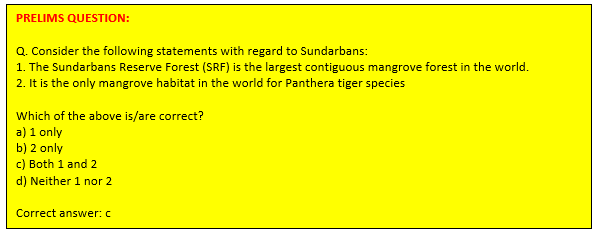Description

Copyright infringement not intended
Context: Birders, wildlife enthusiasts and forest officials have sighted 145 different bird species during the first Sundarban bird festival.
Details:
- Two threatened bird species of the Sundarbans, Eurasian Curlew and Lesser Sand Plover, were also spotted. Birders were able to spot seven of the 12 species of kingfishers found in the Sundarbans.
- A publication by Zoological Survey of India, (ZSI) in 2021, had recorded 428 bird species in the Sundarbans which is one-third of all the avian species found in the country.
- Despite being home to so many species of birds the habitats face threats including plantation activity along the chars(river islands) which disturbs the birds, and illegal activities along chars and uninhabited islands.
.jpeg)
About:
- The Sundarbans mangrove forest, one of the largest such forests in the world (140,000 ha), lies on the delta of the Ganges, Brahmaputra and Meghna rivers on the Bay of Bengal.
- It is adjacent to the border of India’s Sundarbans World Heritage site inscribed in 1987.
- The site is intersected by a complex network of tidal waterways, mudflats and small islands of salt-tolerant mangrove forests, and presents an excellent example of ongoing ecological processes.
- The area is known for its wide range of fauna, including 260 bird species, the Bengal tiger and other threatened species such as the estuarine crocodile and the Indian python.
Universal value:
- The Sundarbans Reserve Forest (SRF) is the largest contiguous mangrove forest in the world.
- The Sundarbans is of universal importance for globally endangered species including the Royal Bengal Tiger, Ganges and Irawadi dolphins, estuarine crocodiles and the critically endangered endemic river terrapin (Batagur baska).
- It is the only mangrove habitat in the world for Panthera tigris species.
- The Sundarbans provides a significant example of on-going ecological processes as it represents the process of delta formation and the subsequent colonization of the newly formed deltaic islands and associated mangrove communities. These processes include monsoon rains, flooding, delta formation, tidal influence and plant colonization.
- As part of the world’s largest delta, formed from sediments deposited by three great rivers; the Ganges, Brahmaputra and Meghna, and covering the Bengal Basin, the land has been moulded by tidal action, resulting in a distinctive physiology.

Integrity:
- The Sundarbans is the biggest delta, back water and tidal phenomenon of the region and thus provides diverse habitats for several hundreds of aquatic, terrestrial and amphibian species.
- The World Heritage property is comprised of three wildlife sanctuaries which form the core breeding area of a number of species of endangered wildlife.


https://epaper.thehindu.com/ccidist-ws/th/th_delhi/issues/24665/OPS/G1AAS4GQJ.1+G46AS53KN.1.html

















